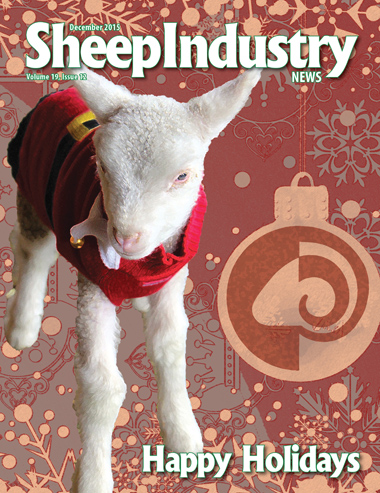To View the December 2015 Digital Issue — Click Here

Call to Action on Bighorn Sheep, Grazing Allotments
Burton Pfliger, ASI President
People share some of the same behaviors of sheep in that we are herd animals. Often times, we travel with the flock but rely on others to tackle the tough and somewhat menial tasks of daily life. Like sheep, we continue to graze at the table of life enjoying the bounty and the safety associated with large groups.
Where we differ is sometimes we justify our inaction, or lack thereof, by telling ourselves, “This problem doesn’t affect me,” or “Someone else will get it done,” and “After all I am to busy, I have a ranch to run.” So, we continue on our way relying on the efforts of others to support our membership to the group.
In sheep bands you always find the strongest individuals toward the center of the flock, with the weaker pushed to the outside where they are vulnerable to the pitfalls and predators of nature. Humans are much alike as we find the strongest members at the center of the action. But we differ from sheep by finding those strongest members doing battle in the center of the group, fully embroiled in the heat of the action and vulnerable to the predators of society. Thank you to all you center dwellers who have provided ASI with your knowledge, time and talents in the past.
We need all of you again (not just the center dwellers but the whole flock) to contact your congressional delegation and express your support for the language ASI submitted to force the U.S. Forest Service to provide replacement allotments of similar forage, reasonable proximity and like animal units for producers displaced by risk based models showing possible contact with bighorn sheep.
We, as a whole, need to realize that the fight over grazing allotments on federal lands is one that we must win, and one that will have a chilling affect on us all. While I hear your argument that this doesn’t affect you, I want to remind us all of the “big picture.” The intermountain region of the country houses the largest and most concentrated areas of sheep production. ASI estimated it comprised 38 percent of the domestic production of lamb and wool. Another large processor cited this area as holding 60 percent of their supply. Each of us, if we are honest with ourselves, know any business model that shorts its self 38 to 60 percent of its supply or operations does not operate long without either closing or dramatically reducing their foot print.
This is what is at stake for the entire sheep industry. Infrastructure, infrastructure and infrastructure is at stake. Should we lose this important component of our industry, we all will see losses in marketing opportunities and lack of competition for the products we produce.
Congressional leaders were set to address the issue with an Interior Appropriations Bill sometime before the end of the year. ASI submitted proposed bill language in the fall with respect to bighorn sheep and the federal government’s insistence on separating wild and domestic sheep on federal lands.
While evidence of disease transmission between the two is inconclusive at best, the U.S. Forest Service has taken steps to rescind domestic sheep grazing allotments with long-term tenants on behalf of the bighorn sheep.
Just last month, attorneys for the Idaho Wool Growers Association argued the merits of the “Payette Principles” case in front of a three-judge panel from the Ninth Circuit Court of Appeals. The forest service shut down nearly all domestic sheep grazing in the area several years ago without consulting all available experts, including Dr. Don Knowels and Dr. Maggie Highland of the Agricultural Research Service. The action in Payette broke up family ranches and put producers out of business. We, as a group, need to stand up for our principals, our fellow producers and our way of life.
Regardless of the outcome of that case, the industry is taking steps to assure Western producers’ rights to graze on federal lands. The Forest Service, as well as the Bureau of Land Management, have long offered alternative allotments to those pushed off their leases due to drought and wildfire. The new wording proposed by ASI pushes for the same arrangement when domestic sheep are removed from leases due to the presence of bighorn sheep.
But we aren’t stopping there.
Suggested language for the fiscal year 2016 omnibus bill includes the following, “Provided further, that the Secretaries of Agriculture and Interior shall engage the respective states’ wildlife agencies, departments of agriculture, animal health professionals, and the Agricultural Research Service prior to any decision, based partially or in its entirety on the determination of a potential conflict with bighorn sheep, resulting in the reduction or elimination of a domestic livestock permit or lease.”
These groups are experts in their field, and should be consulted before any hard and fast decisions are made concerning bighorn sheep, domestic sheep and their presence on federal lands. This was not the case when with the Payette National Forest several years ago.
ASI issued a call to action in the final days of October urging sheep producers and others to contact their congressional leaders in support of these language changes. My senator from North Dakota, Sen. Hoeven is very supportive and willing to place the language into the appropriations bill. However, there is not a lot of Forest Service land in North Dakota. Each of you needs to exercise your congressional delegations and find a few champions to stand with Sen. Hoeven on this issue. Those living in the affected states are very critical to the success of the language being inserted into law.
Read ASI’s suggested language in our Legislative Action Center at SheepUSA.org/IssuesPrograms_LegislativeActionCenter.


